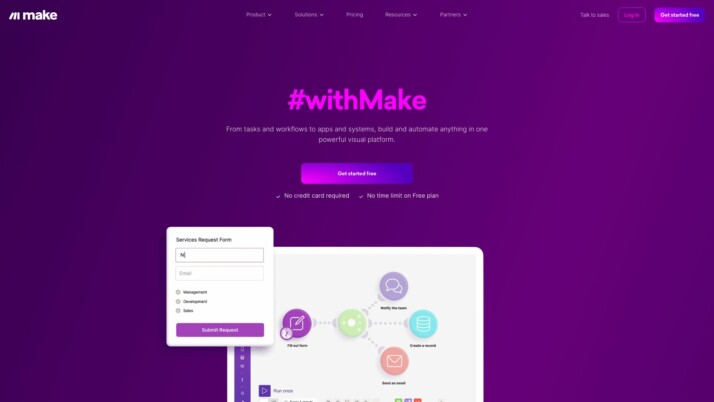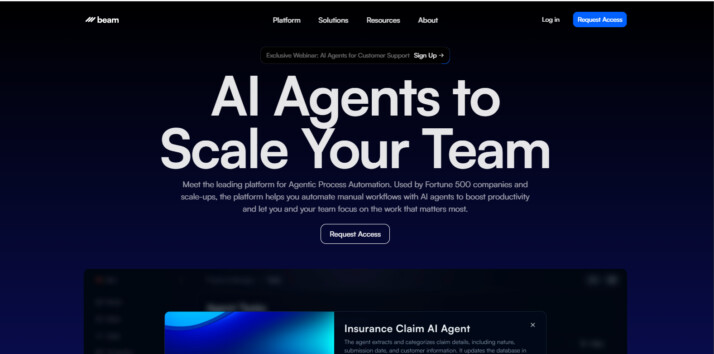Make.com vs. Beam AI: Comparing AI-Powered Automation Tools
AI-powered automation revolutionizes how businesses operate, streamline processes, and boost productivity. This comparison delves into Make.com’s visual workflow builder, Beam AI’s specialized AI agents, and SmythOS’s comprehensive AI development platform. We explore each solution’s strengths, limitations, and ideal use cases to help you choose the right tool for your automation needs. Whether you’re a developer seeking advanced AI capabilities, a business leader focused on scalability, or a non-technical user looking for accessible solutions, this guide provides insights to inform your decision-making process. Discover how these platforms stack up in features, ease of use, and versatility to empower your organization’s AI-driven transformation.
Make.com Overview
Make.com empowers users to create powerful automated workflows without coding. The platform’s visual interface allows drag-and-drop construction of complex processes, connecting over 1000 apps and services. Make.com caters to businesses of all sizes, from solopreneurs to large enterprises, offering scalable solutions for workflow automation.


Make.com empowers users to create powerful automated workflows without coding. The platform’s visual interface allows drag-and-drop construction of complex processes, connecting over 1000 apps and services.
Make.com’s strength lies in its versatility and ease of use. The platform enables users to build ’scenarios’ — automated workflows that can handle data manipulation, app integrations, and scheduled tasks. These scenarios can range from simple two-step processes to intricate multi-app workflows, accommodating diverse business needs across industries.
While Make.com excels in workflow automation, it lacks some advanced AI capabilities. The platform doesn’t offer AI agents or autonomous decision-making features. However, it compensates with robust error handling, conditional logic, and data transformation tools. Make.com’s execution logs provide transparency, allowing users to debug and optimize their workflows effectively.
Make.com’s collaborative features shine in team environments. The platform supports multiple user roles and permissions, facilitating teamwork on complex automation projects. This makes it particularly suitable for businesses looking to streamline operations across departments.
Make.com’s collaborative features shine in team environments. The platform supports multiple user roles and permissions, facilitating teamwork on complex automation projects.
Integration is a key focus for Make.com. The platform supports OAuth and API key authentication, allowing secure connections to a wide array of third-party services. While it doesn’t offer native AI integrations, its extensive app library and webhook support provide ample opportunities for creating AI-enhanced workflows by connecting to external AI services.
Beam AI Overview
Beam AI crafts generative AI agents to automate repetitive tasks, boosting productivity for organizations. Their Agentic Process Automations (APAs) excel at data extraction, customer inquiry management, compliance tasks, and order optimization. These agents continuously learn, enhancing precision and efficiency over time.
Beam AI focuses on back-office automation, customer service, compliance, and order processing. The platform’s AI-native solutions emphasize sustainability, minimizing steps to achieve goals and reducing human carbon footprints. Speed stands as a core value, with automation solutions designed to save time and enhance efficiency.
Beam AI crafts generative AI agents to automate repetitive tasks, boosting productivity for organizations. Their Agentic Process Automations (APAs) excel at data extraction, customer inquiry management, compliance tasks, and order optimization.


Beam AI’s agents feature advanced conversational interfaces for seamless interaction and efficient task management. They integrate with existing internal systems to plan and execute workflows, providing comprehensive automation solutions. The company envisions creating a sustainable, ethical future using AI, aiming to build agents capable of tackling complex workflows and improving through continuous learning.
The company envisions creating a sustainable, ethical future using AI, aiming to build agents capable of tackling complex workflows and improving through continuous learning.
While Beam AI offers powerful automation capabilities, it lacks some features found in more comprehensive platforms. The absence of a visual builder or no-code editor may limit accessibility for non-technical users. Additionally, there’s no mention of debug modes, multimodal capabilities, or human-AI interaction features, which could restrict its versatility in certain use cases.
Beam AI’s focus on specific automation tasks positions it as a specialized tool rather than an all-encompassing AI development platform. For organizations seeking targeted solutions in areas like back-office automation or customer service, Beam AI presents a compelling option. However, those requiring a more extensive suite of AI development tools may need to look elsewhere or supplement Beam AI with additional platforms.
Feature Comparison
Make.com and Beam AI offer distinct approaches to workflow automation and AI-powered task management. Make.com provides a robust visual builder for creating complex automated workflows without coding, connecting over 1000 apps and services. Its strength lies in versatility and ease of use, allowing users to build ’scenarios’ that handle data manipulation, app integrations, and scheduled tasks. Make.com excels in collaborative features, supporting multiple user roles and permissions for team environments.
In contrast, Beam AI focuses on generative AI agents designed for specific back-office automation tasks like data extraction, customer inquiry management, and compliance. Beam AI’s agents continuously learn and adapt, enhancing precision over time. However, Beam AI lacks some features found in more comprehensive platforms like Make.com. The absence of a visual builder or no-code editor in Beam AI may limit accessibility for non-technical users. Additionally, Beam AI doesn’t mention debug modes or human-AI interaction features, which could restrict its versatility compared to Make.com’s more extensive toolkit for workflow automation.
Feature Comparison Table
| Make.com | Beam AI | SmythOS | |
|---|---|---|---|
| CORE FEATURES | |||
| AI Agents | ❌ | ✅ | ✅ |
| Hosted Agents (Dev, Production) | ❌ | ✅ | ✅ |
| Environments (Dev, Production) | ❌ | ✅ | ✅ |
| Visual Builder | ✅ | ❌ | ✅ |
| No-Code Options | ✅ | ❌ | ✅ |
| Memory & Context | ❌ | ✅ | ✅ |
| Autonomous Agents | ❌ | ✅ | ✅ |
| Explainability & Transparency | ❌ | ✅ | ✅ |
| Debug Tools | ✅ | ❌ | ✅ |
| Multimodal | ❌ | ❌ | ✅ |
| Problem-Solving Capabilities | ❌ | ✅ | ✅ |
| Multi-Agent Collaboration | ❌ | ✅ | ✅ |
| Human-AI Interaction | ❌ | ✅ | ✅ |
| SECURITY | |||
| Constrained Alignment | ❌ | ✅ | ✅ |
| Data Encryption | ❌ | ✅ | ✅ |
| IP Control | ❌ | ✅ | ✅ |
| COMPONENTS | |||
| Foundation AIs | ❌ | ✅ | ✅ |
| Huggingface AIs | ❌ | ✅ | ✅ |
| Zapier APIs | ❌ | ✅ | ✅ |
| Classifiers | ❌ | ✅ | ✅ |
| Data Lakes | ❌ | ❌ | ✅ |
| DEPLOYMENT OPTIONS (EMBODIMENTS) | |||
| Deploy as API | ❌ | ✅ | ✅ |
| Staging Domains | ❌ | ✅ | ✅ |
| Production Domains | ❌ | ✅ | ✅ |
| Deploy as Site Chat | ❌ | ✅ | ✅ |
| DATA LAKE SUPPORT | |||
| Hosted Vector Database | ❌ | ❌ | ✅ |
| Sitemap Crawler | ❌ | ❌ | ✅ |
| YouTube Transcript Crawler | ❌ | ❌ | ✅ |
| URL Crawler | ❌ | ❌ | ✅ |
| PDF Support | ❌ | ✅ | ✅ |
| Word File Support | ❌ | ✅ | ✅ |
| TXT File Support | ❌ | ✅ | ✅ |
Best Alternative to Make.com and Beam AI
SmythOS emerges as the superior alternative to Make.com and Beam AI, offering a comprehensive AI automation platform that combines the best features of both while addressing their limitations. Our drag-and-drop interface rivals Make.com’s visual builder, allowing users to create complex AI workflows without coding. Unlike Beam AI’s focus on specific back-office tasks, SmythOS provides unlimited use cases, from chatbots to data analysis.
SmythOS emerges as the superior alternative to Make.com and Beam AI, offering a comprehensive AI automation platform that combines the best features of both while addressing their limitations.
We excel in ease of use, offering an intuitive platform accessible to both technical and non-technical users. Our feature set surpasses both competitors, with advanced capabilities like multimodal support, problem-solving AI agents, and seamless multi-agent collaboration. SmythOS integrates with a wide range of AI models and APIs, providing flexibility that Make.com and Beam AI can’t match.
Unlike Make.com’s limited AI capabilities and Beam AI’s narrow focus, SmythOS offers true AI agent functionality. Our agents possess memory and context awareness, enabling more intelligent and context-appropriate responses. We provide robust debugging tools and explainability features, addressing limitations in both Make.com and Beam AI.
SmythOS stands out with its deployment versatility. Users can deploy AI solutions as APIs, website chatbots, or scheduled agents, catering to diverse business needs. Our platform also offers superior data handling capabilities, including support for various file types and a hosted vector database, features lacking in both Make.com and Beam AI.
SmythOS stands out with its deployment versatility. Users can deploy AI solutions as APIs, website chatbots, or scheduled agents, catering to diverse business needs.
By choosing SmythOS, users gain a powerful, versatile, and user-friendly AI automation platform that outperforms both Make.com and Beam AI in key areas. Our solution empowers businesses to harness the full potential of AI across a wide spectrum of applications, driving innovation and efficiency at unprecedented levels.
Conclusion
Make.com and Beam AI offer powerful automation solutions, each with distinct strengths. Make.com excels in visual workflow creation, connecting over 1000 apps without coding. Its drag-and-drop interface and extensive integrations make it ideal for businesses seeking versatile automation. Beam AI, focusing on generative AI agents, shines in specific back-office tasks like data extraction and customer inquiry management.
While both platforms have their merits, SmythOS emerges as the superior choice for comprehensive AI development and deployment. We combine the best of both worlds – offering an intuitive visual builder like Make.com and advanced AI capabilities reminiscent of Beam AI. Our platform goes further, providing hosted agents, multimodal interactions, and seamless deployment options.
SmythOS stands out with its ability to create once and deploy anywhere, supporting various environments from development to production. Our platform offers unparalleled flexibility, allowing deployment as APIs, webhooks, scheduled agents, or even GPTs. With features like autonomous agents, multi-agent collaboration, and a hosted vector database, SmythOS provides a complete ecosystem for AI development.
For those ready to experience the future of AI automation, explore our diverse range of AI-powered agent templates or create a free SmythOS account to start building unlimited AI agents at no cost. Discover how our 300,000+ integrations can revolutionize your workflow and deploy AI agents seamlessly across multiple platforms. Join us in shaping the next generation of AI-powered solutions.
Last updated:
Disclaimer: The information presented in this article is for general informational purposes only and is provided as is. While we strive to keep the content up-to-date and accurate, we make no representations or warranties of any kind, express or implied, about the completeness, accuracy, reliability, suitability, or availability of the information contained in this article.
Any reliance you place on such information is strictly at your own risk. We reserve the right to make additions, deletions, or modifications to the contents of this article at any time without prior notice.
In no event will we be liable for any loss or damage including without limitation, indirect or consequential loss or damage, or any loss or damage whatsoever arising from loss of data, profits, or any other loss not specified herein arising out of, or in connection with, the use of this article.
Despite our best efforts, this article may contain oversights, errors, or omissions. If you notice any inaccuracies or have concerns about the content, please report them through our content feedback form. Your input helps us maintain the quality and reliability of our information.
